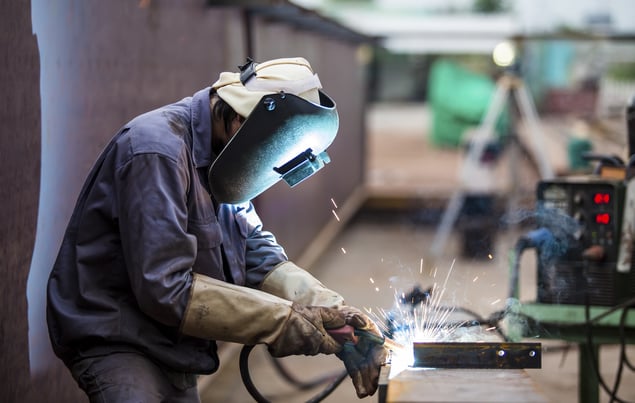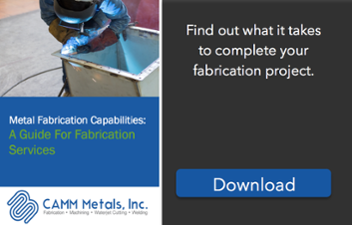In a welding operation, mistakes don’t just mean a less-than-perfect final product. Instead, mistakes made during the welding process can result in added necessary cleanup and rework that can be very costly. In order to avoid extra costs in your welding operation, you should do what you can to avoid costly mistakes. Here are some of the worst mistakes in a welding operation and how to avoid them.

1. Improper Machine Setup
When your operator does not properly set up the machine or provides the incorrect parameters for an application, the result is often a poor welding performance. Improper machine setup can lead to increased spatter or incomplete fusion, which will lead to excess time and money spent on cleanup and rework. When possible, you should have procedures in place that specify the correct voltage and wire speed or invest in technology that requires these specifications. For example, some power sources has welding processes that require pre-set welding parameters that remove guesswork when setting up the machine. If you’re unsure of the proper setup and parameters, welding equipment distributors can provide guidance.
2. Bad Cables or Connections
Loose cable connections or damaged cables can impact the quality of the welding arc. Damaged cables can cause drops in voltage. When the voltage drops, the heat into the weld, which can lead to an inconsistent weld quality. A bad connection can increase spatter in a weld, leading to more time and money spent on cleanup. A bad connection can be caused by a number of factors, including bad setup, failure to properly tighten the cables, gradual loosening over time, and damage from daily wear and tear. The best way to avoid these issues is to install the cables properly and to regularly check the connection to fix any issues before they become severe.
3. Improper Gas Flow or Pressure
Improper gas flow or improper pressure of the shielding gas can lead to serious issues in weld quality. These problems can occur when the gas level is turned up too high or when the gas lines to the machine are too long. Often times, shops without air conditioning will set the gas pressure too high. This is because these shops run fans to keep workers cool, and operators will turn up the gas level to compensate for fans blowing away the shielding gas. When gas levels are too high, it can cause additional spatter, complete fusion, and an unstable welding arc. When gas levels are too low, it can cause weld defects because the weld pool is not properly shielded. Ensuring proper gas pressure is the best way to avoid these issues.
You should also keep the gas line as long as the application allows. Typically, the line extends from the gas supply to the wire feeder. If the hose is long, pressure can build up and inflate in the hose when the operator is not welding. Excess pressure will then release when the operator pulls the gun trigger, leading to an unstable welding arc, spatter, and porosity in the arc starts. The gas regulator should be as close as possible to the feeder to help ensure correct pressure and prevent a surge of gas. In addition to the costly spatter and defects that improper gas flow and pressure can lead to, they can also cause operators to waste gas, which can also be a significant cost.
4. Overlooking Preventative Maintenance
One of the best ways to prevent issues in your welding operation is to keep up with preventative maintenance. Regular care and inspection will prevent many of these issues, so you should plan to conduct maintenance during routine pauses in the welding operation to avoid additional downtime. Common maintenance steps include looking for loose connections and wear and tear. You should also replace contact tips, gas diffusers, and retaining heads. Be sure to clean out the liner periodically with a compressed air track and to track how long the liner typically lasts in order to change it at the right time. When you overlook this preventative maintenance, you can end up with mistakes and low-quality welds that will be expensive to fix.
5. Too Much Anti-Spatter
Using too much anti-spatter, misusing anti-spatter, or using anti-spatter in the wrong places can all lead to problems in your welding operation. The purpose of anti-spatter is to prevent spatter from the welding arc from sticking to the part and consumables on the welding gun. When you use too much anti-spatter, the spray can enter the weld joint, resulting to poor weld performance, more spatter, and added problems with weld penetration. Soaking consumables on the welding gun in anti-spatter can cause issues as well. This process can cause the insulator in the nozzle to degrade prematurely, leading to extra costs for replacement consumables and weld quality repairs. It will also lead to an increase in downtime for changeover, which will limit productivity. In order to avoid issues caused by too much anti-spatter, you should always check the correct settings and parameters for your application, which will reduce the need for anti-spatter spray.
CAMM Metals | CT Welding Company
It's crucial to do your research when choosing a metal fabrication, as not all companies are capable of completing the same quality of work. CAMM Metals has years of experience, honing our skills across the board to deliver a quality product and measurable bottom line value to our customers.



